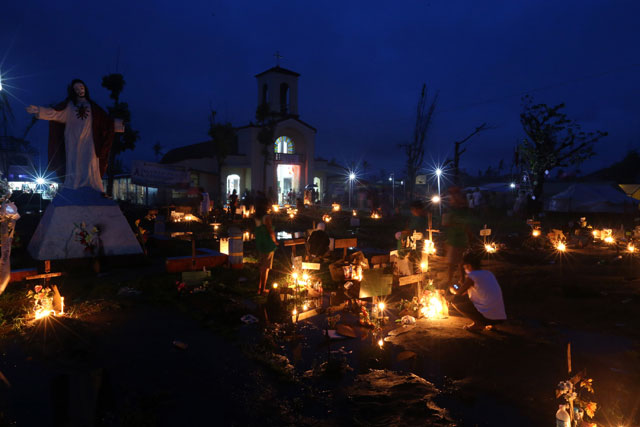SUMMARY
This is AI generated summarization, which may have errors. For context, always refer to the full article.

MANILA, Philippines (UPDATED) – Nearly two months since Super Typhoon Yolanda (Haiyan) devastated the Visayas, rehabilitation czar Panfilo Lacson said the burial of the bodies lying in open fields is finally underway.
The burial started on Thursday, January 2 and is expected to be finished by Tuesday, January 7 – at the latest, according to Lacson, who quoted a status report from Health Undersecretary Janette Garin.
Earlier, Lacson, presidential assistant for rehabilitation and recovery, said the burial would be finished before Sunday, January 5.
“Hopefully, all bodies can be buried by Tuesday, weather permitting,” read a text message from Garin forwarded by Lacson.
“[We] will augment personnel [on Saturday] and download funds ASAP so as to finish temporary and permanent burial by Monday,” added Garin.
The undersecretary gave the following breakdown of the mass burial as of Friday, January 3, 9 pm:
- Total bodies at the temporary mass burial site in Basper – 1,200
- Total buried processed cadavers at the Holy Cross Cemetery in Tacloban City – 186 (from 40 at 1 pm)
- Total buried unprocessed cadavers at the newly opened gravesite in Suhi – 112
- Total rebagged cadavers – about 600
- Total remaining cadavers on the ground – about 200
Lacson said the national government is working with local governments in the effort.
“The Department of Health, through Undersecretary [Janette] Garin, sent body bags and other protective kits. The Department of Public Works and Highways, through Secretary [Rogelio] Singson, provided the backhoe and the payloader,” Lacson said.
“The National Bureau of Investigation (NBI), through Officer in Charge Director Medardo de Lemos, sent his forensic team,” he added.
The former senator though clarified that the burial of the bodies is not under his jurisdiction as rehabilitation czar.
“It was early morning of January 1 when I first learned about [the unburied bodies]. I started calling the parties concerned, which I mentioned earlier. I merely coordinated to prevent possible finger-pointing of responsibilities after I learned about it,” Lacson said.
“I merely established the communication link between the LGU (mayor and his city administrator) and the national agencies.”
Lacson earlier described his job as an “overall manager coordinator.” He also has no direct control over funds, which pass through other agencies.
The world’s most powerful typhoon, Yolanda flattened entire towns and cities, and left 4.4 million homeless when it hit the Visayas on November 8.
The deadliest disaster to hit the Philippines in recent history killed 6,166, based on the government’s official death count as of Friday, 6 am.
‘Not 1,400 bodies as media reported’
The mass burial came after Agence France-Presse reported that 1,400 corpses were on a muddy open field in San Isidro, a farming village on the outskirts of hard-hit Tacloban City. Journalists also found bodies left unburied in other Yolanda-devastated areas 7 weeks after the disaster. (READ: After Haiyan: No man left behind)
Yet Lacson said that the 1,400 figure is not accurate “because [media] might have included those exhumed in another area and transferred to the present mass burial site.”
Asked how many bodies the government counts as unburied, Lacson said, “As of this morning, the total bagged [cadavers] are 600 and total on the ground is 200.”
In an interview with Bombo Radyo, Health Undersecretary Garin said the department aims to finish the mass burial in 4 to 5 days to stop the spread of the stench affecting residents.
A representative of the World Health Organization (WHO) said though that the mass burial is not permanent. The WHO witnessed the mass burial in Tacloban on Thursday.
“The burial site here is temporary and thus only shallow excavation [was done] to enable easy access later when authorities will have to take out a cadaver for identification by relatives,” the WHO’s Sioban Ruddel told the local Freeman newspaper.
Tacloban Mayor Alfred Romualdez told ABS-CBN that the bodies are already in advanced state of decomposition and need to be buried right away even without identification.
“Ililibing ang di pa na-process. ‘Pag nag-umpisa mag-process, saka i-exhume ang bodies that need to be processed,” Romualdez explained. (We will bury even bodies that have not yet been processed. When the processing starts again, that’s when we will exhume the bodies that need to be processed).
Fast-tracking identification
In a press briefing Thursday, Palace Communications Secretary Sonny Coloma acknowledged the delay in the burial of the bodies. He said the burial was “urgent and important” but said the identification process delayed it.
Coloma said the government asked the NBI to fast-track the process.
“Based on the observation of some agencies, and this had been conveyed to the NBI, maybe the procedures could be modified since Interpol procedures were used to gather evidence in criminal cases and were thus more detailed,” Coloma said.
“Victims of the calamity are not similarly situated as victims of crimes, so I think that is a point that may be discussed,” he said. – Rappler.com
Add a comment
How does this make you feel?
There are no comments yet. Add your comment to start the conversation.